Who Is Dennis Te Kloese?
Dennis te Kloese’s appointment as Feyenoord’s technical director came at the same time as Arne Slot was preparing the first-team squad for a season that would ultimately result in their first Eredivisie title win since the 2016/17 season when Giovanni van Bronckhorst led De club aan de Maas to league title glory.
It was a very memorable debut season at the club for the 49-year-old Dutchman, who’d spent the entirety of his career in North America, mostly in Mexico.
From 2003 until 2018, he held various roles for Chivas, Tigres UANL, and the Mexican national team.
He then became a director at MLS franchise LA Galaxy for three years.
On departing the USA, Te Kloese embarked on a new challenge — this time in his native Netherlands as the technical director of a Feyenoord side on the up, having moved from fifth place in 2020/21 under Dick Advocaat to third in 2021/22 under Arne Slot in the promising young coach’s first campaign at De Kuip.
One of Te Kloese’s well-known successes thus far in his time as Feyenoord boss is undoubtedly his achievement of tying Slot down to a new contract until 2026 just under a year ago
, in May 2023, at a time when the coach was said to be attracting interest from plenty of clubs, including EPL regulars Tottenham Hotspur.
That continuity and stability should serve Feyenoord well over the coming seasons.
Quality and experience are present in key areas, which will fill fans and players alike with confidence in the project.
This analysis will examine some other key areas of Te Kloese’s work with the Dutch giants thus far, focusing mostly on recruitment and squad composition.
It will also examine the Dutchman’s expert knowledge of the North American/Mexican market and how Feyenoord has used that knowledge to turbo-charge its success.
It will be, in part, a data analysis piece, using data and statistics relevant to the areas we’re discussing to explain Te Kloese’s work further.
Feyenoord Transfer Activity
Feyenoord’s transfer activity is something Te Kloese can expect his work at the club to be judged on considerably.
In an interview last summer with the Dutch publication ‘De Volkskrant’, Te Kloese, fresh off Feyenoord’s title win and entering another transfer window, explained his habit of conducting extensive scouting work even during his time off, declaring: “It’s wonderful work and I can’t resist.”
Of course, as Te Kloese also granted, Feyenoord will have dedicated scouts whose job it truly is to identify and evaluate players of interest for the club; still, this bit of insight sheds an exciting light on the hands-on nature of Te Kloese’s relationship with the scouting and recruitment processes in place at De Kuip.
As Te Kloese arrived in the summer of 2022, Feyenoord became something of a talent shop with a heap of demand.
This was the transfer window that saw Luis Sinisterra depart for Leeds United, Tyrell Malacia go to join Erik ten Hag’s Manchester United project, Marcos Senesi head to Bournemouth, and Fredrik Aursnes leave swap the Netherlands for Portugal as he took on a new challenge at Benfica.
Along with Bryan Linssen’s move to Urawa Reds in the J1 League, these were the five departures that brought in transfer fees for Feyenoord last term — and those fees totalled €69.3m, the highest total De club aan de Maas has ever generated from player sales.
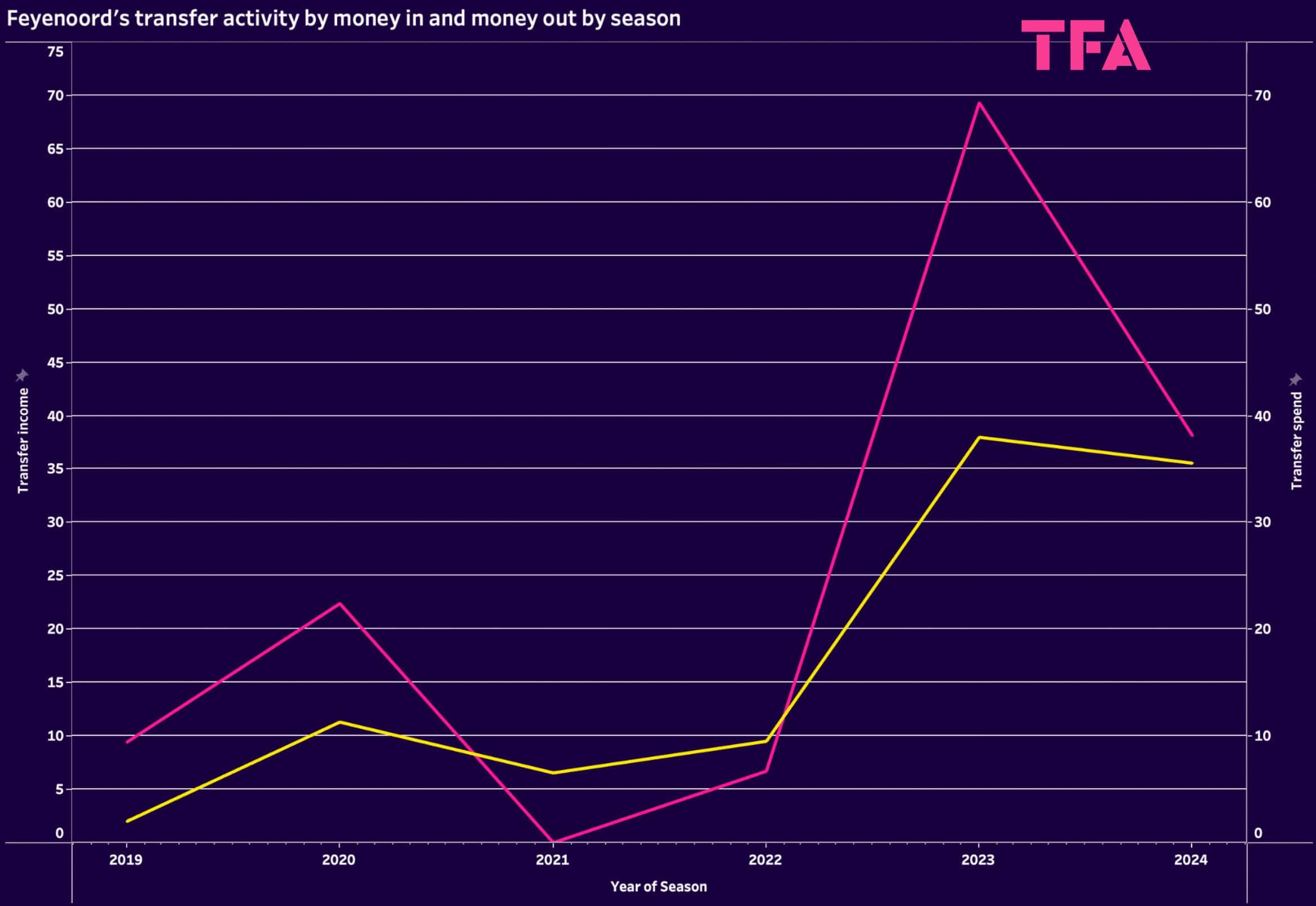
A lot of things go through one’s mind when such an occurrence happens, none the least of which is that the money must be reinvested.
However, that reinvestment needed to be done intelligently, as we know it’s very easy to burn money in football.
Feyenoord reinvested about half the money they received from player sales in new signings that summer, with Dávid Hancko, Quinten Timber, Santiago Giménez, Igor Paixão, Javairô Dilrosun, Sebastian Szymanski (loan), Mats Wieffer and Danilo all coming in, gelling quickly and playing key roles in Slot’s title-winning outfit.
Te Kloese can take great pride in overseeing the intelligent and wise reinvestment of those funds, making sure the 2022/23 summer transfer window doesn’t just go down as the one in which Feyenoord made the most from player sales but arguably the best transfer window in the club’s history, especially when considering value for money with the most expensive of the signings listed above being Hancko who came in for €8.3m; the 26-year-old centre-back is now valued at €35m by Transfermarkt.
Hancko’s not the only one of those signings who’s seen his value and overall hype increase as a result of his Feyenoord move.
Timber was signed for €7.4m, valued at €4m by Transfermarkt, now valued at €22m.
Paixão was signed for €4.5m, valued at €800k by Transfermarkt; he’s now valued at €15m.
Dilrosun was signed for €4m and sold for €4.6m to Club América.
Wieffer was signed for €575k, valued at €400k by Transfermarkt, now valued at €18m.
Danilo was signed on a free transfer after failing to make an impact at Ajax; a year later, he was sold to Scottish Premiership side Rangers for €6.3m.
These market values in and of themselves are to be taken with a grain of salt.
Nevertheless, they are good indicators of players’ reputations and how they’ve grown exponentially since joining Feyenoord, likely leading to them departing for a heftier fee than De club aan de Maas paid for them.
From these examples, we can see how Feyenoord’s recruitment that summer added immense value to the squad and ultimately only enhanced their funds further with the potential for future sales that they added to the squad.
Of course, signing the right players for the manager to ensure they’d have the best possible chance of showing what they’re capable of, signing players who will acclimatise well and adapt nicely to the squad are all important considerations and targets that Feyenoord didn’t seem to miss by much — further credit to their recruitment processes.
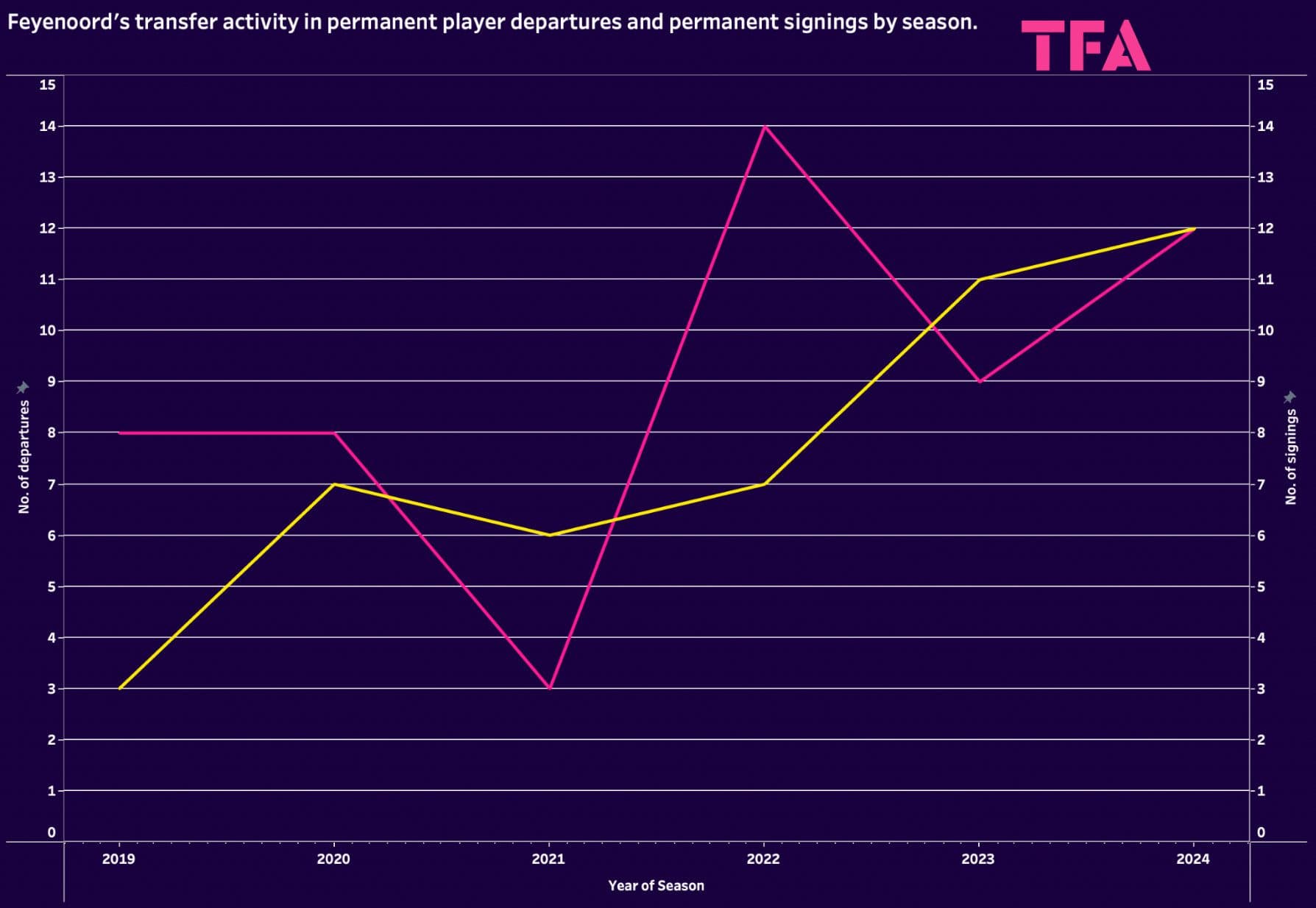
It’s impressive that Slot managed to gel his squad together as well as he did last season. He guided a team largely comprised of new players to the league title, with many of those signed playing important roles.
It’s never sustainable to have an extremely high player turnover continuously, however.
With new arrivals rising to unprecedented levels for the past five seasons in 2023/24, Feyenoord has provided us with an example of how it takes time for a player to settle in, especially when many of that player’s teammates are also new to the club.
Ayase Ueda, a stellar goalscorer in the Belgian Pro League, Ramiz Zerrouki, Thomas Beelen, and Bart Nieuwkoop, who were signed last summer, will need time before we can judge their acquisitions and their personal performances, but they haven’t hit the ground running as could be expected given the high turnover in this team over the past couple of seasons.
Still, Feyenoord’s coup of bringing Calvin Stengs, a Slot player from his time at AZ Alkmaar, into the fold for just €6m will undoubtedly prove to be a brilliant bit of business that’ll make the spending of the 2023/24 summer transfer window well worth it in the long run, though surely not as impressive as that of the 2022/23 summer!
Regional knowledge
With his years of experience in North American football, specifically Mexico, Te Kloese is well placed to act as a bridge between Feyenoord and top talent emerging from the Mexican market who may want to take that step to challenge themselves in Europe.
Feyenoord fans can be confident that their technical director has his finger on the pulse of that particular market. This is clear from their signing of Santiago Giménez for €6m in the 2022 summer transfer window.
Of course, Giménez is another whose market value has skyrocketed since arriving in the Eredivisie, moving from €4m at the time of his arrival to €50m today.
Santiago Giménez Shots Map
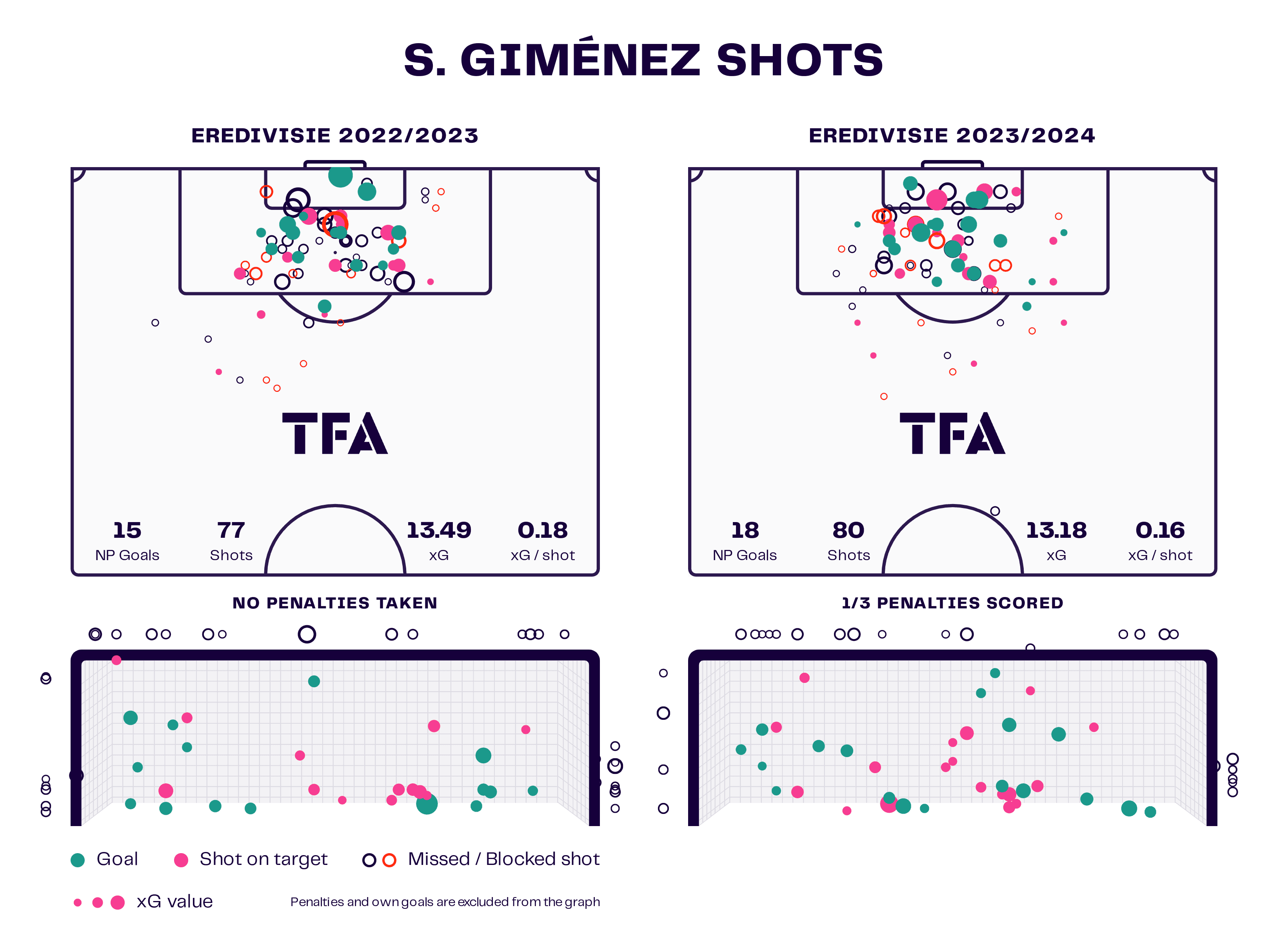
This is thanks in no small part to the 22-year-old forward’s immense goalscoring record in the Dutch top-flight, with Giménez’s strikes proving crucial to Feyenoord’s title charge last term — 15, placing him fourth in the Eredivisie’s goalscoring charts for that season and 19, at the time of writing, placing him third at the moment for the 2023/24 campaign.
Again, like most players, especially young players, Giménez needed time and didn’t hit his stride until the second half of 2022/23.
Still, his acquisition was obviously well worth it for Feyenoord and will ultimately prove to be a very smart business decision.
As Te Kloese divulged to De Volkskrant, Cruz Azul didn’t want to sell Giménez and didn’t need the money from his sale.
However, the player himself wanted the move.
Te Kloese’s connection with the Mexican market and his personal relationship with the player’s family sealed the deal, which will prove a very profitable one for the Dutch club whenever the time comes to move the young forward.
Feyenoord haven’t signed any other players from Mexico thus far during Te Kloese’s tenure.
Still, with the quality Giménez has brought to De club aan de Maas, they can be confident they have someone involved with the recruitment process who’s very much in touch with what would represent a worthy signing for the Eredivisie club from this region.
A decision-maker with this type of regional knowledge can always give their club a head start on others when it comes to extracting talent from that particular region.
If it’s one with plenty of untapped talent, then that could work out very well for said club before others catch up.
It’s then up to the club and all the different people involved with it to communicate clearly and directly in order to put processes in place that can best utilise the available knowledge, as Feyenoord have in this case with Te Kloese and the signing of Giménez.
Clubs must consider this kind of specialist when appointing, for instance, a technical director—provided the specialist knowledge matches up in terms of being in an area where the club can clearly see a relevant application.
When you then have that harmony across the club, it can be very profitable in many ways, as Feyenoord are providing a clear example of here.
Feyenoord Squad composition: Reducing the average age
The third and final element of Te Kloese’s work with Feyenoord thus far that we’re going to discuss in this analysis is squad composition—specifically, how Te Kloese has overseen the de-ageing process for Slot’s Feyenoord squad.
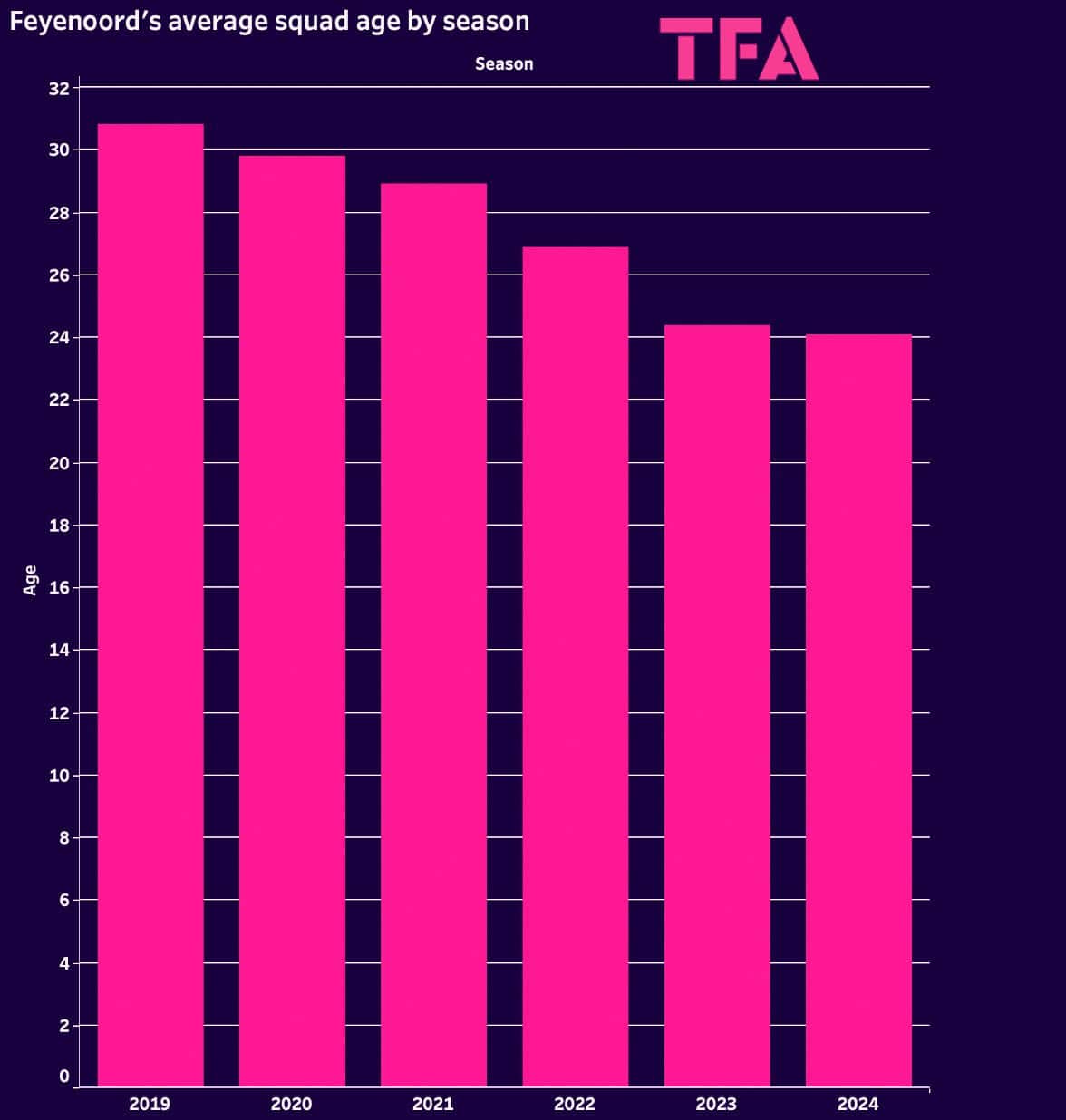
The average age of Feyenoord’s squad has declined sharply over the past five seasons, but that decline has accelerated over the past two seasons during Te Kloese’s tenure as technical director.
Back in 2018/19, Feyenoord had the fifth-oldest squad of the 18 teams in the Dutch Eredivisie, with an average age of 30.8.
In 2021/22, the season prior to Te Kloese’s arrival, Feyenoord were middle of the road, with the joint-ninth oldest/youngest squad in the league — 26.9.
Following the summer transfer window of 2022/23, that dropped sharply to the joint-second youngest squad at 24.4 years of age. This season, their average age sits at 24.1, making them the fourth-youngest side in the Eredivisie.
In terms of signing players with resale value, they don’t have to be extremely young, but it certainly helps.
Furthermore, youthful energy and moldable young players can work well with the high-intensity out-of-possession system that coach Arne Slot advocates for.
In addition to those factors, it must be said that a club’s reputation will always influence players when making moves.
When young players see other young players going to Feyenoord, playing an attractive brand of football, achieving success, and building their reputations, it makes the club a desirable destination and an intriguing proposition when they come in.
So, overall, it has made sense for Feyenoord to reduce their average squad age over time, with Te Kloese quickly overseeing that final sharp drop from middle of the road to the current levels.
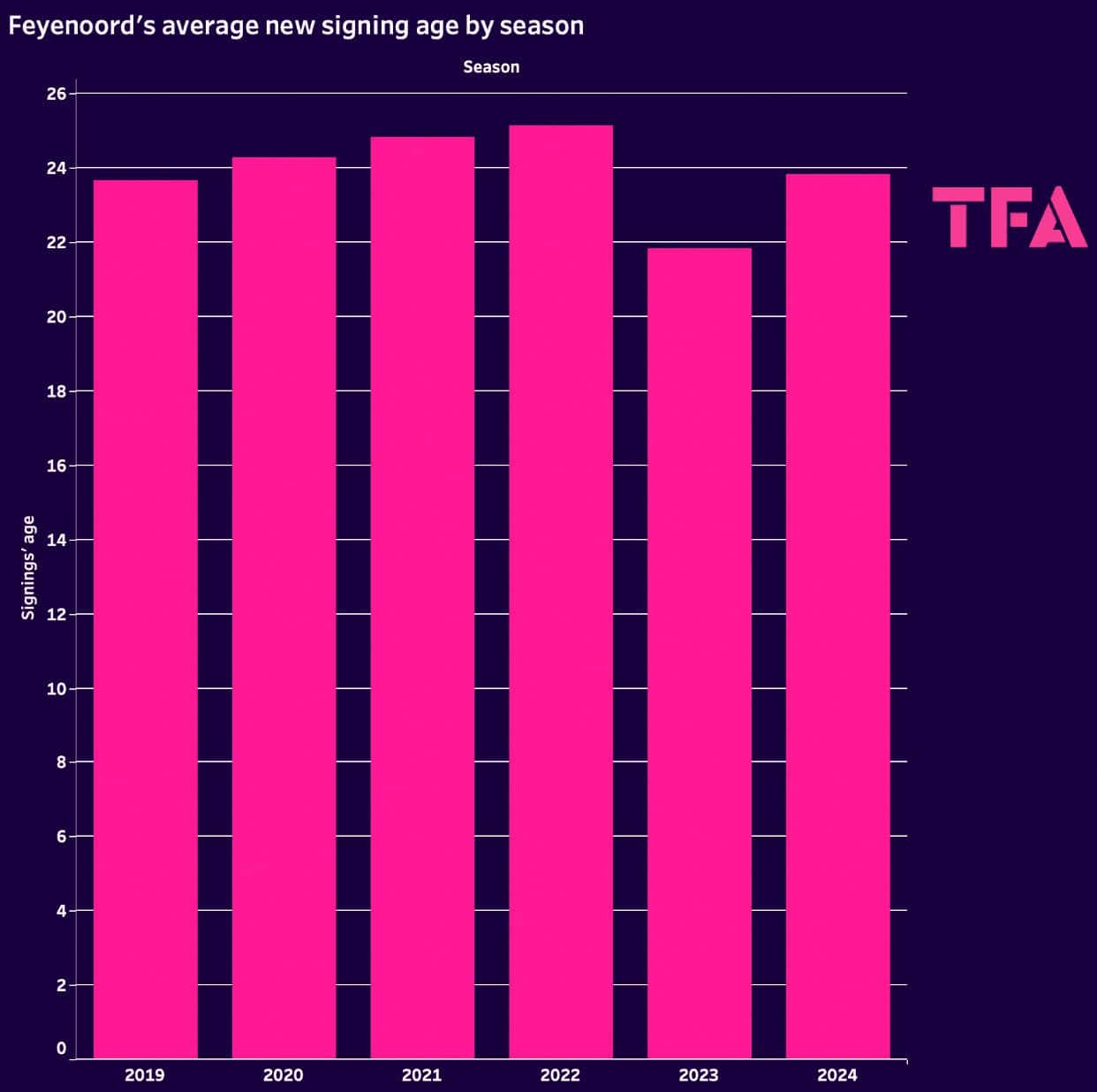
Lastly, figure 5 highlights how the incomings of Te Kloese’s reign in the technical director role have generally been on the younger end of the scale when put in the context of the past five seasons.
Again, this hammers home the point that the new technical director has made an effort to ensure that average age drops in addition to everything else he’s achieved in his short time with De club aan de Maas.
Conclusion
To conclude this analysis, Te Kloese is by no means solely responsible for Feyenoord’s success since his arrival, nor is Slot, any one player or any other person involved with the club.
Ultimately, to achieve success in the highest levels of football, you need harmony throughout the club, with knowledgeable, qualified people occupying all the key decision-making positions.
Feyenoord is an excellent example of a club that has successfully implemented a winning structure over the past couple of seasons.
Te Kloese, like the highly sought-after Slot, has been a vital part of that structure.
It’ll be interesting to see how Feyenoord progresses over the next few years to truly assess how well Te Kloese implements his long-term vision and strategy for the team. This is generally more relevant to a sporting director or technical director than short-term results.





Comments